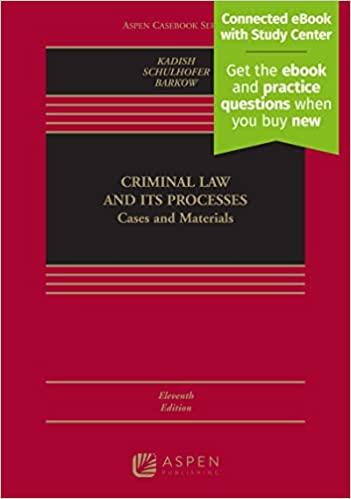Question
CASE: While driving under the influence of alcohol, Joe runs off the road and wrecks his car.As the car turns over, the protruding door latch
CASE:
While driving under the influence of alcohol, Joe runs off the road and wrecks his car.As the car turns over, the protruding door latch hits the ground and the door flies open.Joe who is not wearing his seat belt is thrown from the car and is badly hurt.Joe sues the car manufacturer, asserting that the door latch was defectively designed.Discuss the legal issues raised by these facts.
Do Case problems according to the case analysis method
CASE ANALYSIS METHOD
1)Briefly summarize the facts of the case- restating the facts in a clear and concise manner ( You must understand the facts of a case before you can attempt to resolve it)
2)Identify the major issue(s) that flow from the facts (Legal issue).Sometimes this process indicates the various avenues of litigation open to the plaintiff.For instance, the issues identified can suggest that both Negligence and Strict Liability may be pursued.
3)Identify the elements of each issue (Determine the relevant elements of each issue.For instance Negligence has: Existence of Duty of care, Breach of that Duty, Proof of Injury and Causation or Proximate Cause).
Sometimes the elements of the Legal Issue may not be very apparent or obvious.In that case DEFINE or DESCRIBE the issue as best as you can according to the text.
4)Discuss the elements of each issue as they apply to the case or apply the description to the facts.
5)Apply the relevant law (Make a decision based on the relevant law).
6)Cite a supporting case (As this is common law, briefly state the facts of the supporting case and show how it can serve as a precedent to your case problem).You can find cases at : Findlaw.com, Westlaw.com, Lexisnexis.com, Lawnix.com, Lawteacher.net. Google Scholar, or even Wikipedia, the online Encyclopedia.
Sample Assignment and Answer Following Case Analysis Method
A.Tort Theories
The Yommers operated a gasoline station. In December 1967 their neighbors, the McKenzies, noticed a smell in their well water, which proved to be caused by gasoline in the water.McKenzie complained to the Yommers, who arranged to have one of their underground storage tanks replaced. Nevertheless, the McKenzies were unable to use their water for cooking or bathing until they had a filter and water softener installed.At the time of the trial, in December 1968, they were still bringing in drinking water from an outside source.The McKenzies sued the Yommers for damages. The Yommers claimed that the McKenzies had not proved that there was any intentional wrongdoing or negligence on their part and that therefore they should not be held liable. Under what theory might the McKenzies recover damages even in the absence of any negligence in the Yommers' part? Explain [Yommer V. McKenzie, 255 Md. 220, 257 A.2d 138 1969)]
A.Tort Theories
1)The McKenzies, who are neighbors to the Yommers' gas station, sued the Yommers after their well water became contaminated by gasoline which had escaped from a defective or broken underground storage tank. The Yommers claim that the McKenzies fail to prove that they were negligent or that there was any intentional wrongdoing so they should not be held liable.
2)In this case, although neither an intentional tort nor negligence may be pursued, strict liability remains a possible avenue for the plaintiffs to attempt to recover compensation.
3)Strict liability by definition is liability without fault. One application of strict liability is that of abnormally dangerous activities which exists in this case. The three characteristics of these activities are that the activity involves potential harm of a serious nature to persons or property, involves a high degree of risk that cannot be completely guarded against by the exercise of reasonable care, and it is not commonly performed in the community or area.
4)The Yommers have taken on a business that does not seem to be common in the area, especially being located so closely to residents of the community. The activity of storing gasoline underground near wells does involve potential harm to persons or property and it also cannot be guarded by the exercise of reasonable care because harmful accidents still have the potential to occur since the gasoline is stored out of reach.
5)In reviewing the facts of the case and applying the characteristics of abnormally dangerous activities under strict liability, I think the verdict should rule in favor of the plaintiffs. The McKenzies should receive compensation and be awarded damages for the occurrence.
6)Supporting Case-The case of Rylands v. Fletcher where the Rylands constructed a reservoir on their land which broke through a filled-in shaft and flooded the passageways of an active coal mine owned by Fletcher. Fletcher sued and the Rylands were held liable on the basis of strict liability.
Step by Step Solution
There are 3 Steps involved in it
Step: 1

Get Instant Access to Expert-Tailored Solutions
See step-by-step solutions with expert insights and AI powered tools for academic success
Step: 2

Step: 3

Ace Your Homework with AI
Get the answers you need in no time with our AI-driven, step-by-step assistance
Get Started


